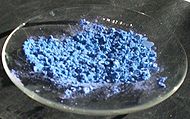Hydrate
In chemistry, a hydrate is a substance that contains water or its constituent elements. The chemical state of the water varies widely between different classes of hydrates, some of which were so labeled before their chemical structure was understood.
Chemical nature
[edit]Inorganic chemistry
[edit]Hydrates are inorganic salts "containing water molecules combined in a definite ratio as an integral part of the crystal"[1] that are either bound to a metal center or that have crystallized with the metal complex. Such hydrates are also said to contain water of crystallization or water of hydration. If the water is heavy water in which the constituent hydrogen is the isotope deuterium, then the term deuterate may be used in place of hydrate.[2][3]
 |

|
| Anhydrous cobalt(II) chloride CoCl2 (blue) |
Cobalt(II) chloride hexahydrate CoCl2·6H2O (pink) |
A colorful example is cobalt(II) chloride, which turns from blue to red upon hydration, and can therefore be used as a water indicator.
The notation "hydrated compound⋅nH2O", where n is the number of water molecules per formula unit of the salt, is commonly used to show that a salt is hydrated. The n is usually a low integer, though it is possible for fractional values to occur. For example, in a monohydrate n = 1, and in a hexahydrate n = 6. Numerical prefixes mostly of Greek origin are:[4]
- Hemi – 0.5
- Mono – 1
- Sesqui – 1.5
- Di – 2
- Tri – 3
- Tetra – 4
- Penta – 5
- Hexa – 6
- Hepta – 7
- Octa – 8
- Nona – 9
- Deca – 10
- Undeca – 11
- Dodeca – 12
- Trideca – 13
- Tetradeca – 14
A hydrate that has lost water is referred to as an anhydride; the remaining water, if any exists, can only be removed with very strong heating. A substance that does not contain any water is referred to as anhydrous. Some anhydrous compounds are hydrated so easily that they are said to be hygroscopic and are used as drying agents or desiccants.
Organic chemistry
[edit]In organic chemistry, a hydrate is a compound formed by the hydration, i.e. "Addition of water or of the elements of water (i.e. H and OH) to a molecular entity".[5] For example: ethanol, CH3−CH2−OH, is the product of the hydration reaction of ethene, CH2=CH2, formed by the addition of H to one C and OH to the other C, and so can be considered as the hydrate of ethene. A molecule of water may be eliminated, for example, by the action of sulfuric acid. Another example is chloral hydrate, CCl3−CH(OH)2, which can be formed by reaction of water with chloral, CCl3−CH=O.
Many organic molecules, as well as inorganic molecules, form crystals that incorporate water into the crystalline structure without chemical alteration of the organic molecule (water of crystallization). The sugar trehalose, for example, exists in both an anhydrous form (melting point 203 °C) and as a dihydrate (melting point 97 °C). Protein crystals commonly have as much as 50% water content.
Molecules are also labeled as hydrates for historical reasons not covered above. Glucose, C6H12O6, was originally thought of as C6(H2O)6 and described as a carbohydrate.
Hydrate formation is common for active ingredients. Many manufacturing processes provide an opportunity for hydrates to form and the state of hydration can be changed with environmental humidity and time. The state of hydration of an active pharmaceutical ingredient can significantly affect the solubility and dissolution rate and therefore its bioavailability.[6]
Clathrate hydrates
[edit]Clathrate hydrates (also known as gas hydrates, gas clathrates, etc.) are water ice with gas molecules trapped within; they are a form of clathrate. An important example is methane hydrate (also known as gas hydrate, methane clathrate, etc.).
Nonpolar molecules such as methane can form clathrate hydrates with water, especially under high pressure. Although there is no hydrogen bonding between water and guest molecules when methane is the guest molecule of the clathrate, guest–host hydrogen bonding often forms when the guest is a larger organic molecule such as tetrahydrofuran. In such cases the guest–host hydrogen bonds result in the formation of L-type Bjerrum defects in the clathrate lattice.[7][8]
Stability
[edit]The stability of hydrates is generally determined by the nature of the compounds, their temperature, and the relative humidity (if they are exposed to air).
See also
[edit]References
[edit]- ^ Greenwood, Norman N.; Earnshaw, Alan (1997). Chemistry of the Elements (2nd ed.). Butterworth-Heinemann. p. 625. ISBN 978-0-08-037941-8.
- ^ Sherry Lewin. Displacement of Water and Its Control of Biochemical Reactions. Academic Press Inc. (London) Ltd. p. 299. ISBN 0124462502.
- ^ Harold C. Urey; G. M. Murphy; F. G. Brickwedde (1933). "A Name and Symbol for H²". Journal of Chemical Physics. 1: 512–513. doi:10.1063/1.1749326.
- ^ Nomenclature of Inorganic Chemistry Archived 2018-07-09 at the Wayback Machine. IUPAC Recommendations 2005. Table IV Multiplicative Prefixes, p. 258.
- ^ IUPAC, Compendium of Chemical Terminology, 2nd ed. (the "Gold Book") (1997). Online corrected version: (2019) "Hydration". doi:10.1351/goldbook.H02876
- ^ Surov, Artem O., Nikita A. Vasilev, Andrei V. Churakov, Julia Stroh, Franziska Emmerling, and German L. Perlovich. "Solid Forms of Ciprofloxacin Salicylate: Polymorphism, Formation Pathways and Thermodynamic Stability". Crystal Growth & Design (2019). doi:10.1021/acs.cgd.9b00185.
- ^ Alavi S.; Susilo R.; Ripmeester J. A. (2009). "Linking microscopic guest properties to macroscopic observables in clathrate hydrates: guest-host hydrogen bonding" (PDF). The Journal of Chemical Physics. 130 (17): 174501. Bibcode:2009JChPh.130q4501A. doi:10.1063/1.3124187. PMID 19425784. Archived from the original on 2020-04-13. Retrieved 2010-09-09.
- ^ Hassanpouryouzband, Aliakbar; Joonaki, Edris; Vasheghani Farahani, Mehrdad; Takeya, Satoshi; Ruppel, Carolyn; Yang, Jinhai; J. English, Niall; M. Schicks, Judith; Edlmann, Katriona; Mehrabian, Hadi; M. Aman, Zachary; Tohidi, Bahman (2020). "Gas hydrates in sustainable chemistry". Chemical Society Reviews. 49 (15): 5225–5309. doi:10.1039/C8CS00989A. hdl:1912/26136. PMID 32567615. S2CID 219971360.
Text is available under the CC BY-SA 4.0 license; additional terms may apply.
Images, videos and audio are available under their respective licenses.
